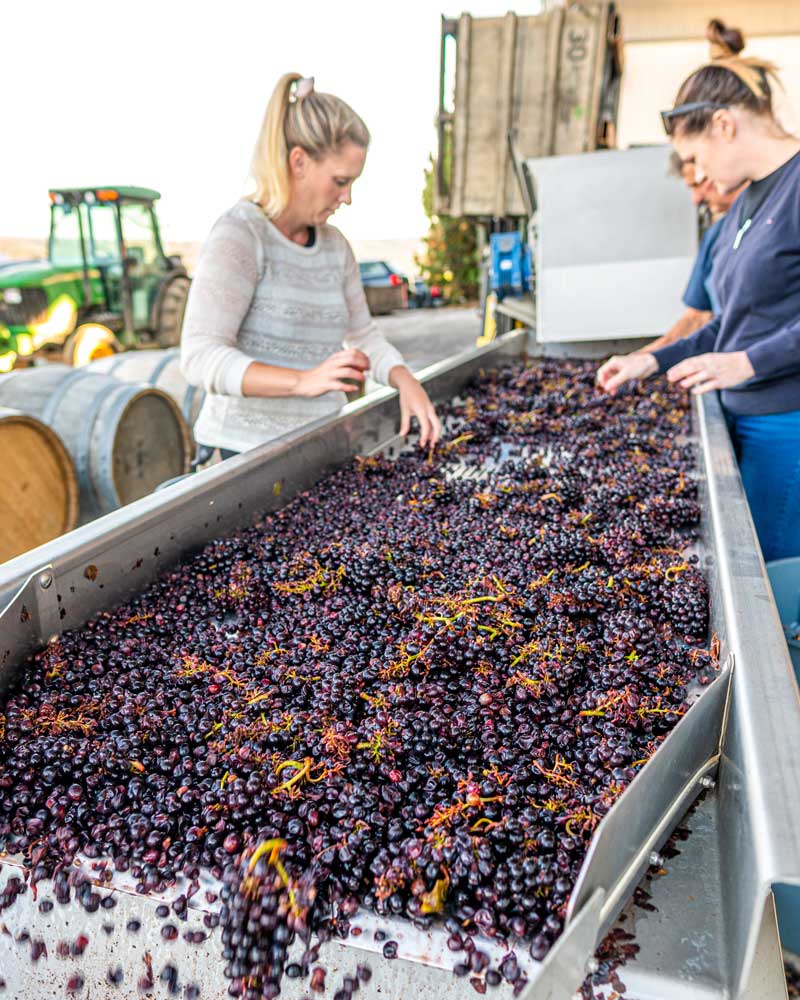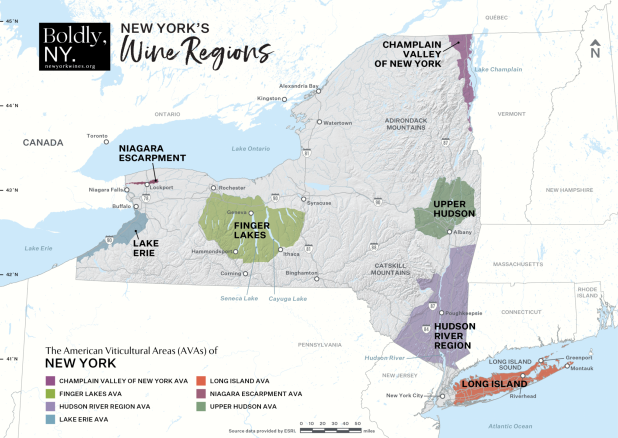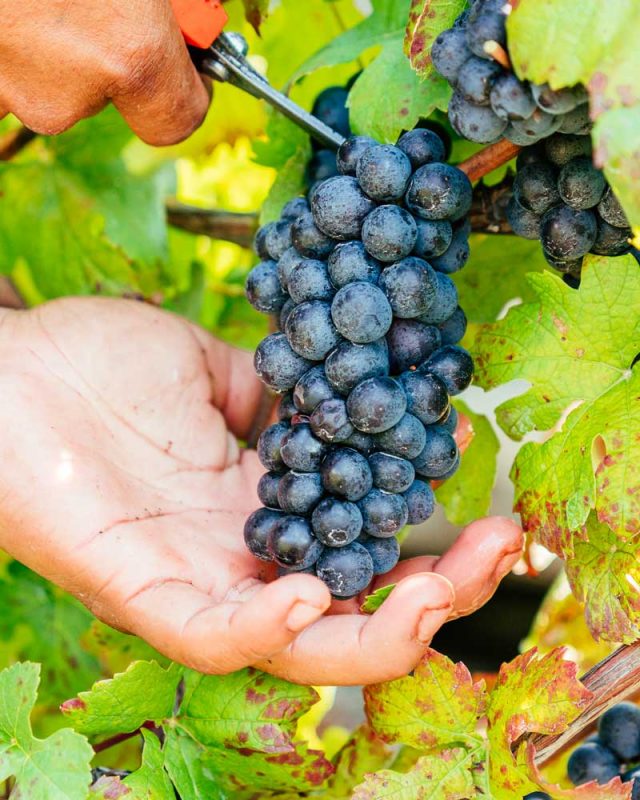A New York State of Wine

by Tod Stewart
feature image: sorting Pinot Noir at Dr. Konstantin Frank Winery | photo from Dr. Konstantin Frank Winery website
The Statue of Liberty, Empire State Building, Times Square, Central Park, Broadway…just a few of the associations that pop to mind when New York is mentioned. And these landmarks are all clustered in New York City. Stretching farther afield, add in Ellis Island, Lake Placid, The Catskills, The Adirondacks, and many more, including – as far as wine-lovers are concerned – the Finger Lakes.
While the Finger Lakes region is probably the most recognized wine-growing area in New York, we shouldn’t forget that the Empire State is home to over 35,000 vineyard acres (14,164 hectares) of wine country, and is the United State’s third largest wine-producing state. Vineyards can be found from Long Island, along the Hudson River, up to the Champlain Valley, and west of the Finger Lakes to the shores of Lake Erie. Yet for most wine consumers, the Finger Lakes region is the one most synonymous with wine, and there are a few reasons why this area stands out.

“We are on the cusp of where you should be growing grapes,” Rick Rainey, general manager of Forge Cellars, admits. “If it wasn’t for the lakes to the north, and Seneca Lake, it wouldn’t be possible. Great things are always grown where nothing is guaranteed. It is as if Mother Nature rewards those with enough passion to give it a go in a cold climate. The long season is really special.”
That being said, a “cusp climate” poses some unique challenges (ask any Canadian winemaker). “From a viticultural perspective the Finger Lakes is a cold place in the winter,” Meaghan Frank, vice president, Dr. Konstantin Frank Winery, points out. “This can lead to bud, cane, and trunk damage anytime we have below freezing temperatures. The deep glacial lakes help to act as a heat trap to warm the area during our harsh winters. One practice we do to mitigate this, which was a technique introduced by Konstantin, is a technique called ‘hilling up,’ where a foot of soil is collected around the graft union of the vine to protect from the cold winters. [This practice is, in fact, employed in cool-climate viticultural regions around the world.]
Of course, cold-climate growing areas like the Finger Lakes has – like practically all wine regions around the world – not been immune to the impact of global climate change.
“Climate change has made all of our weather more severe,” informs Frank. “Things we have never had to worry about in the past – like spring frosts and drought – are becoming an issue in certain growing seasons. We are investigating wind machines and drip irrigation systems, things I would have never thought that we would ever need. It is forcing us to think more creatively and try to get ahead of these new challenges.”
Hand in hand with adapting to climate change is the quest by New York wineries to ensure their industry remains sustainable well into the future; a goal that once again brings with it some limitations.
“Cultivation of organically certified vitis vinifera grapes in New York is difficult, if not economically impossible given the state’s high precipitation and humidity,” according to Justin Jackson, sustainability program manager at the New York Wine & Grape Foundation. “However, many vineyards throughout the state are taking steps to reduce pesticide inputs by planting hybrid grapes, or through intensive IPM [Integrated Pest Management] programs. New York growers also support local ecosystems with uncultivated woodlands and grasslands around their vineyards, and promote healthy soils through robust cover crops and erosion planning. Over 50 vineyards have been certified sustainable by the New York Sustainable Winegrowing program in 2023, demonstrating their commitment to environmental, social, and economic sustainability.”
Hybrid grape varieties – including Traminette, Seyval Blanc, Cayuga, Vidal, Vignoles, and Marechal Foch offer advantages such as cold heartiness and disease resistance (as do widely planted native labrusca varieties like Concord and Catawbwa), most winemakers shooting for international flavours (and international quality) opt for tried-and-true vinifera varieties.

“Riesling is the great story teller of terroir, and we have lots of stories to tell,” enthuses Rick Rainey. “The long ripening curve that Riesling brings in the Lakes, along with the low potential alcohol are a wonderful combination.” Rainey also feels that Pinot Noir and Cabernet Franc may be promising newer additions. “Pinot can give great interest if the farming is on point, which is no easy task. Cabernet Franc can give joyous, fun wine, with enough complexity to have you reaching for another and another glass.”
Photo: Pinot Noir | photo from Dr. Konstantin Frank Winery website
Frank’s vineyards are home to 17 different vinifera varieties, including “the usual suspects” (Riesling, Chardonnay, Merlot, etc.) as well as Pinot Noir. However, she is particularly interested in some varieties that are entirely sensible choices, if not somewhat surprising.
“We are very excited about Austrian varieties like Gruner Veltliner and Blaufrankish, as well as the Georgian varieties Rkatsiteli and Saperavi,” she admits, adding that Alsatian varieties like Pinot Blanc, Pinot Gris, Muscat Ottonel, and Gewurztraminer all show increasing promise in the Finger Lakes. “We focus on Northern European varieties that have a degree of cold hardiness. For us, finding the right planting site, rootstock and soil type is critical to the success of the variety.”
Next time you’re looking to try wines that might be a bit out of the box for you, consider exploring what the United States east coast has to offer. They might not (yet) be as popular as their sunny west coast counterparts, but they are definitely cooler.
All of the following Finger Lakes wines surprised me with exceptional varietal character, and overall exceptional quality. While not inexpensive ($25 – $35), they are fairly-priced for what you are getting.
Dr. Konstantin Frank Dry Riesling 2021
Classic Riesling aromas of lime, honeysuckle, beeswax, gunflint, and mild petrol lead to a crisp, racy, zesty, lime and mineral-laced palate, with undertones of buckwheat honey. It finishes long and lively, with crisp acidity, perfect balance, and notable length.
Forge Cellars Dry Riesling “Classique” 2020
Benefiting from an outstanding vintage in the state, and gains added complexity from a portion of barrel-aged wine that is blended into the tank-fermented remainder. Loaded with rich, ripe aromas of apricot, lime pie, a touch of petrol, and a suggestion of crème brûlée that reappear in the mouth, with crunchy, chewy apricot, butterscotch, apple, and touch of mineral/spice that drift off into a long, mouth-watering finish.
Lamoreaux Landing Unoaked Chardonnay 2021
Chardonnay purists will appreciate the sophisticated elegance of this “pure” Chardonnay expression. On the nose, expect ripe pear, acacia/white flower blossom, flint/mineral and a suggestion of tropical fruit/banana. Ripe and round, yet at the same time crisp and balanced, it offers up flavours leaning towards pear, baked apple, and mineral, with a slight hint of spice that segue into long, complex, citrus fruit-laced end notes.
